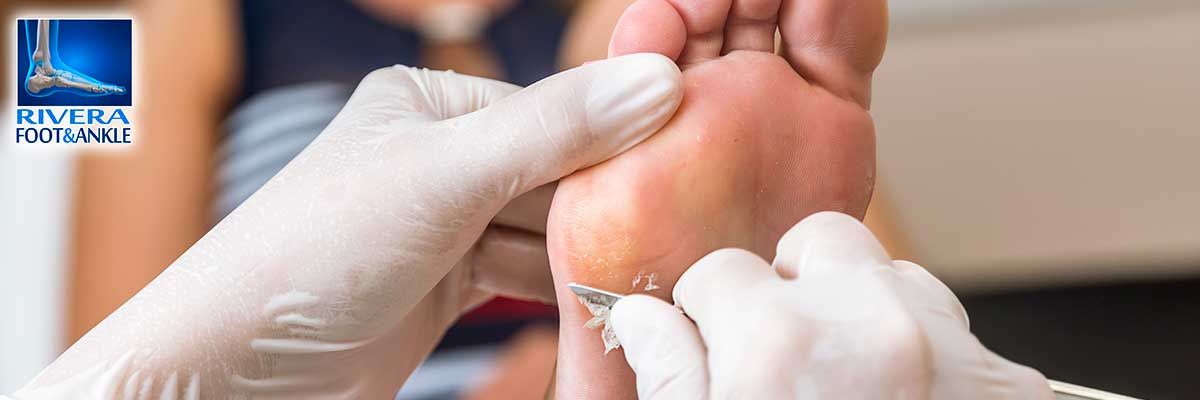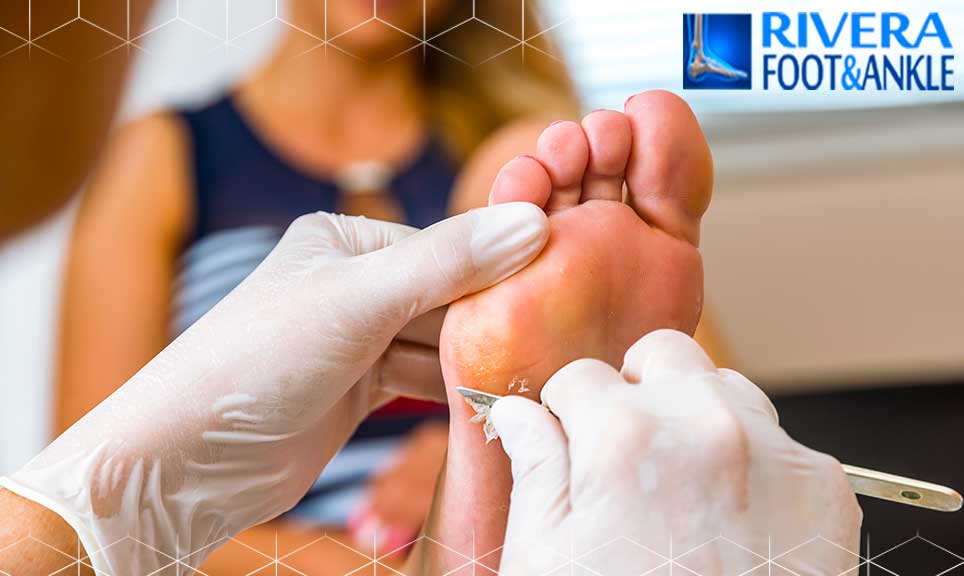
Podiatrist in Houston
Why Do Corns and Calluses Develop?
Causes corns and calluses
The small bones of the toes and feet are broader and more lumpy near to the small joints of the toes. If there is repeated friction or pressure on the skin overlying a small rough area of bone, this will cause the skin to thicken. This may lead to corns or calluses forming.
The common causes of rubbing and pressure are tight or ill fitting shoes which tend to cause corns on the top of the toes and side of the little toe. Also, too much walking or running which tends to cause calluses on the bottom of the feet (the soles). So if you do sports or activities that involve repeated pressure on your feet then this will increase your risk of developing a callus.
Corns and calluses are more likely to develop if you have very prominent bony toes, thin skin, or any deformities of the toes or feet which cause the skin to rub more easily inside shoes. People with bunions are more likely to develop corns and calluses.
What are the treatments for corns and calluses?
If you develop a painful corn or callus it is best to obtain expert advice from a person qualified to diagnose and treat foot disorders. You should not cut corns yourself, especially if you are elderly or have diabetes.
Treatments such as corn plasters will reduce the pressure on your corn but will not actually treat the corn.
Advice and options to treat corns and calluses include the following:
Trimming (paring down)
The thickened skin of a corn or callus can be pared down by a podiatrist by using a scalpel blade. The pain is usually much reduced as the corn or callus is pared down and the pressure on the underlying tissues eased. Sometimes, repeated or regular trimming sessions are needed. Once a corn or callus has been pared down, it may not return if you use good footwear.
If the skin seems to be thickening up again, a recurrence may be prevented by rubbing down the thickening skin with a pumice stone or emery paper once a week. Many people can do this themselves. It is best to soak your foot in warm water for 20 minutes to soften the thick skin before using a pumice stone or emery paper. A moisturising cream used regularly on a trimmed corn or callus will keep the skin softened and easier to rub down.
Chemical treatment
There are different types of medicated products which work by chemically paring down the thickened, dead skin on corns and calluses. These usually contain salicylic acid, which is also present in many wart-removal products.
All these treatments will turn the top of your skin white and then you will be able trim or peel away the dead tissue. This results in the corn sticking out less, which will make it less painful.
Although these products can work well, they should not be used if you have diabetes or poor circulation. This is because your skin is less likely to heal well after using salicylic acid and there is a risk that an ulcer may develop.
Shoes and footwear
Tight or ill fitting shoes are thought to be the main cause of most corns and calluses. Sometimes a rough seam or stitching in a shoe may rub enough to cause a corn. The aim is to wear shoes that reduce pressure and rubbing on the toes and forefeet. Shoes should have plenty of room for the toes and have soft uppers and low heels. High heels, especially if they are tight fitting, can lead to repeated friction and make corns and calluses worse. In addition, extra width is needed if corns develop on the outer side of the little toe. Extra height is needed if corns develop on the top of abnormal toes such as 'hammer' or 'claw' toes.
Correcting poor footwear will reduce any rubbing or repeated friction on your skin. In many cases, a corn or callus will go away if rubbing or pressure is stopped with improved footwear. If you have had a corn or callus pared away, a recurrence will usually be prevented by wearing good footwear. If you are able, going barefoot when not outdoors will also help.
Some people with abnormalities of their feet or toes will need special shoes to prevent rubbing. A podiatrist can advise you about this.
Footpads and toe protection.
Depending on the site of a corn or callus, a cushioning pad or shoe insole may be of benefit. For example, for a callus under the foot, a soft shoe insert may cushion the skin and help the callus to heal. If there is a corn between your toes, a special sleeve worn around your toe may ease the pressure. A special toe splint may also help to keep your toes apart to allow a corn between toes to heal. A podiatrist will be able to advise you on any appropriate padding, insoles or appliances you may need.
Surgery
If you have a foot or toe abnormality causing recurring problems, an operation may be advised if all else fails. For example, an operation may be needed to straighten a deformed toe, or to cut out a part of a bone that is sticking out from a toe and causing problems. If you need an operation then you will be referred to a surgeon who will be able to discuss this with you in more detail.
RIVERA FOOT & ANKLE: At Orlando H.Rivera DPM, our priority is to deliver quality care to informed patients in a comfortable and convenient setting. When you have problems with your feet, you need to turn to a podiatrist who listens and responds… an experienced doctor who knows the field and can effectively diagnose and treat your needs… a friendly physician who counsels you on the best ways to maintain and improve your health. Our physician(s) meet all these criteria. Plus, you benefit from a dedicated team of trained professionals who give you the individualized attention you deserve.

Podiatrist Houston
Foot and Ankle, Dr. Orlando Rivera, Advanced Foot & Ankle Specialist, Foot and Ankle Podiatry, Houston Foot & Ankle Surgical, Treatment of Foot and Ankle, Foot & ankle specialists, Podiatrist in houston, podiatrist in houston, Orlando H.Rivera DPM, Houston Foot Doctor, Foot and Ankle Surgeon Houston, Ankle and Foot Specialist Houston, Podiatrist Houston, Foot Pain Houston.



